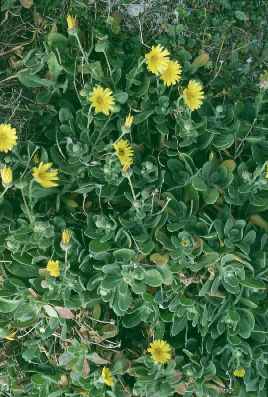- Calendula maritima
Taxobox
name = Sea Marigold
status = CR | status_system = IUCN3.1

image_width = 250px
trend = down
regnum =Plant ae
divisio = Magnoliophyta
classis =Magnoliopsida
ordo =Asterales
familia =Asteraceae
tribus = Calenduleae
genus = "Calendula "
species = "C. maritima"
binomial = "Calendula maritima"
binomial_authority = Guss"Calendula maritima", known as the Sea Marigold, is a very rare species from the family of
Asteraceae . Some scientists regarded it as subspecies "Calendula suffruticosa subsp. maritima (Guss.) Meikle". It is endemic toSicily .Description
This
perennial plant reaches a height between 20 and 40 cm. The stems which can easily lignified on the underparts and the leaves are covered with short sticky hairs. The young stems are first erected, later they began to hang and spreads to the soil. In contrast to the Pot marigold the leaves are fleshy and have a strong smell. The form of the leaves vary from egg-shaped to linear depending on their placement on the stems. The basket-shaped blossoms have a diameter between three and five centimetres and consists of pale yellow single-standing petals. The main flowering period is from May to June.Threats
The Sea Marigold is critically endangered and it occurs only in a small 10 km² large area in the nature reserve
Riserva Naturale Saline di Trapani e Paceco betweenMarsala and theMonte Cofano in theProvince of Trapani in the western part of Sicily. The habitat is under serious threat of destruction due to urban development (e.g. the expanding of the harbour ofMarsala ). Pollution of the salt-works and the competition of invasive plants like the Hottentot fig (Carbobrotus edulis) are further reasons for its rarity. The exact number of plants remaining is unknown.Cultivation
The Sea Marigold occurs also in cultivated form. Most popular is the yellow "Skyfire" which can be seen on patches, balconies, plantations on traffic lights, buckets, and as plant-cover for soils.
References
* Bertrand de Montmollin, Wendy Strahm & IUCN/SSC Mediterranean Islands Plant Specialist Group.: "The top 50 Mediterranean Island plants : wild plants at the brink of extinction, and what is needed to save them."
* Database entry includes justification for why this species is critically endangeredExternal links
* [http://www.iucn.org/THEMES/SSC/our_work/plants/Top50/English/pdfs/Calendula_maritima.pdf IUCN factsheet Calendula maritima]
* [http://www.dipbot.unict.it/phyto_de/territori/distrdrepano/calendula_maritima.html Photographes of Calendula maritima]
Wikimedia Foundation. 2010.
